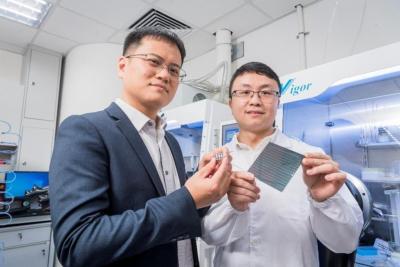Researchers from City University of Hong Kong, National Renewable Energy Laboratory (NREL) and Imperial College London have improved the long-term stability of perovskite solar cells with an atomic-layer deposition (ALD) method that replaces the fullerene electron transport layer with tin oxide.
Professor Zhu Zonglong (left) and Dr Gao Danpeng of City University of Hong Kong hold their innovative solar cells. Image credit: Eurekalert
The team started by depositing the perovskite and the hole-transporter layer in a single step. Then, they used ALD to create an oxygen-deficient tin oxide layer to reduce the band offset to a thicker, overgrown layer of normal tin oxide. Solar cells had a power conversion efficiency of more than 25%, and they retained more than 95% of efficiency after 2000 hours of maximum power point operations at 65°C.
The new fabrication technique could substantially enhance the prospects of commercializing perovskite solar cells through improved stability, reliability, efficiency and affordability. The research offers a simple device structure that can facilitate future industrial production.
"The improvements in stability and the simplification of the production process of perovskite solar cells represent a significant step forward in making solar energy more accessible and affordable," explained Professor Zhu Zonglong of the Department of Chemistry at City University of Hong Kong.
The team has developed two innovations for creating the structure of solar cells. The first innovation is the integration of the hole-selective materials and the perovskite layers, which simplifies the manufacturing process.
The second is that the operational stability of the device is greatly enhanced by using the inorganic electron transport layer, tin oxide, which has excellent thermal stability, to replace traditional organic materials such as fullerene and BCP.
“The device structure reported in this study represents the most simplified architecture in the current field of perovskite solar cells, offering significant advantages for industrialization,” said Dr. Gao Danpeng, co-author of the Science paper and a post-doc at CityUHK.
Specifically, Dr. Gao explained that this solution does not require a traditional organic transfer layer, effectively reducing the material cost in the manufacturing process while greatly simplifying the production steps.
The study has produced promising data. According to Professor Zhu, the team has achieved power conversion efficiencies exceeding 25% by optimizing oxygen vacancy defects within the tin oxide layer while retaining over 95% efficiency after 2,000 hours of continuous operation under rigorous test conditions.
This performance surpasses the stability of traditional perovskite solar cells, meeting several industry benchmarks for longevity. The results pave the way for more reliable and efficient solar cells, simplifying manufacturing processes and making producing solar cells at scale more cost-effective.
The scientists said that the next phase of the study will focus on applying this innovative structure to larger perovskite solar modules, aiming further to enhance the efficiency and scalability of this technology.
“With the potential to be implemented in solar energy systems within the next 5 years, this research is a critical step towards achieving more sustainable and environmentally friendly energy production globally,” Professor Zhu added.




